
 Credit: CXC/M.Weiss
Credit: CXC/M.Weiss
Coronal CatScan
Like the earth, stars themselves are magnetized. These magnetic fields are
generally produced by the motion of hot material in the interior. But
stellar magnetic fields are much more complex than the earth's magnetic
field, since the hot ionized gas in a stellar interior moves in complicated
flows and streams, producing localized strong magnetic fields. Stellar
magnetic activity produces the stellar corona, a region of extremely hot
gas (temperatures exceeding one million degrees) in the outer stellar
atmosphere, and generates other observable phenomena like sunspots and
stellar flares. Such phenomena has been studied on our Sun for over 400
years, but studies of these phenomena on other stars has been possible only
recently. One useful means of studying stellar activity is to study the
X-ray emission produced by the hot stellar corona. We can actually image
the solar corona using space observatories like the Yohko satellite,
but even the next nearest star is too far away for us to directly image the
corona. But astronomers now are using the excellent spatial and spectral
resolution of the Chandra X-ray
observatory to effectively generate an image the
stellar corona in the binary system 44i Bootis. 44i Boo is composed of
2 stars in a tight orbit, making a revolution every 3 hours, as shown above
in this artist's conception of a closeup of the binary. The red arrow
shows the direction of the stellar orbit. The rapid motion of the stars
intensifies the magnetic field and produces a particularly bright corona.
In 44i Boo, spectral line features produced by neon atoms were detected by
Chandra, as shown by the graphs on the right side of the above image. The
relative motion of the stars in their orbits produces a doppler shift this
neon spectral line. By measuring the velocity of the neon lines astronomers
can tell whether the the feature belongs to the star which is approaching
us or the receding one. One surprising result is that most of the emission
is produced by a particularly bright region near the pole of the larger
star.
Last Week *
HEA Dictionary * Archive
* Search HEAPOW
* Education
Each week the HEASARC
brings you new, exciting and beautiful images from X-ray and Gamma ray
astronomy. Check back each week and be sure to check out the HEAPOW archive!
Page Author: Dr. Michael F.
Corcoran
Last modified November 26, 2001


